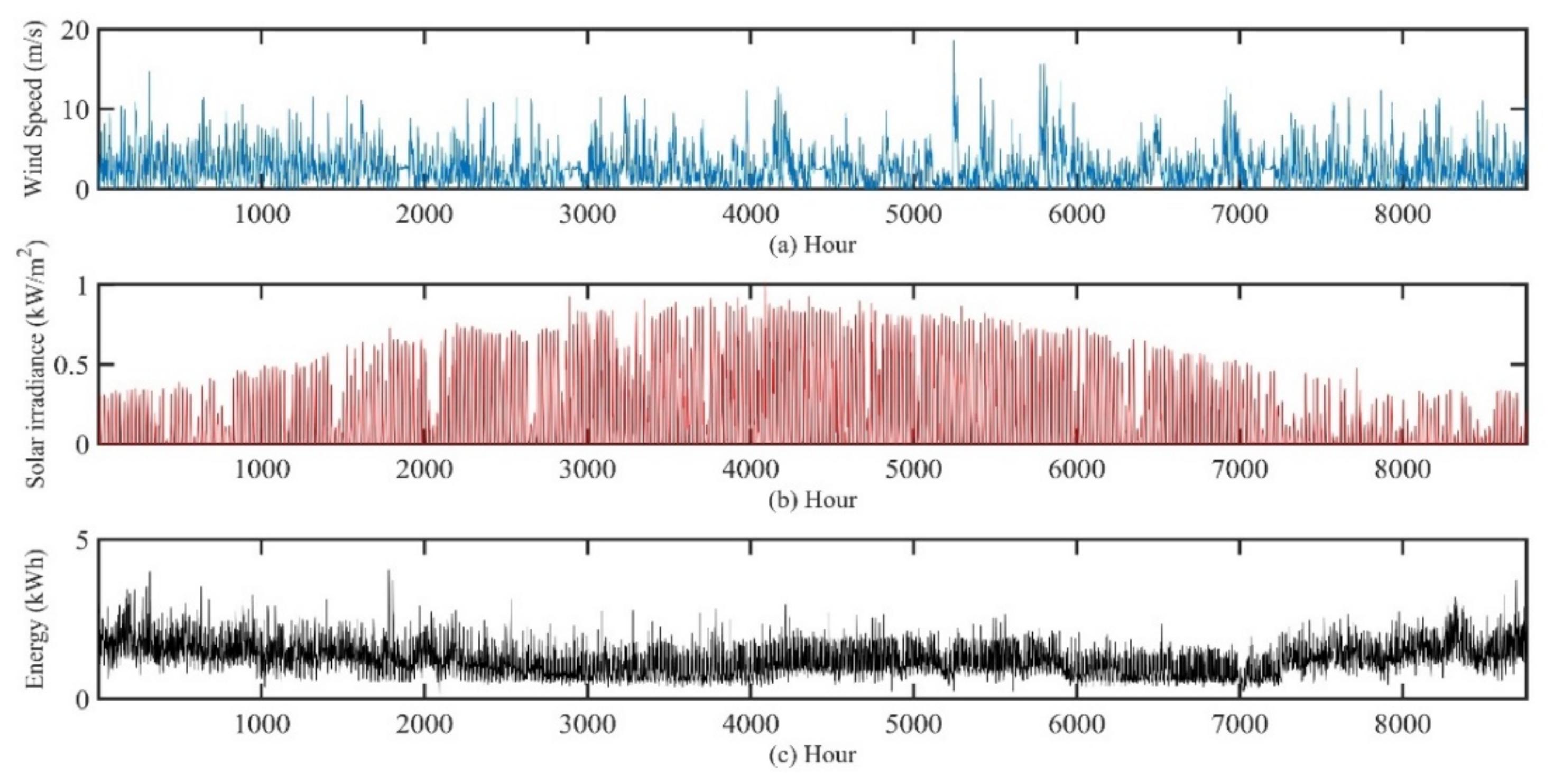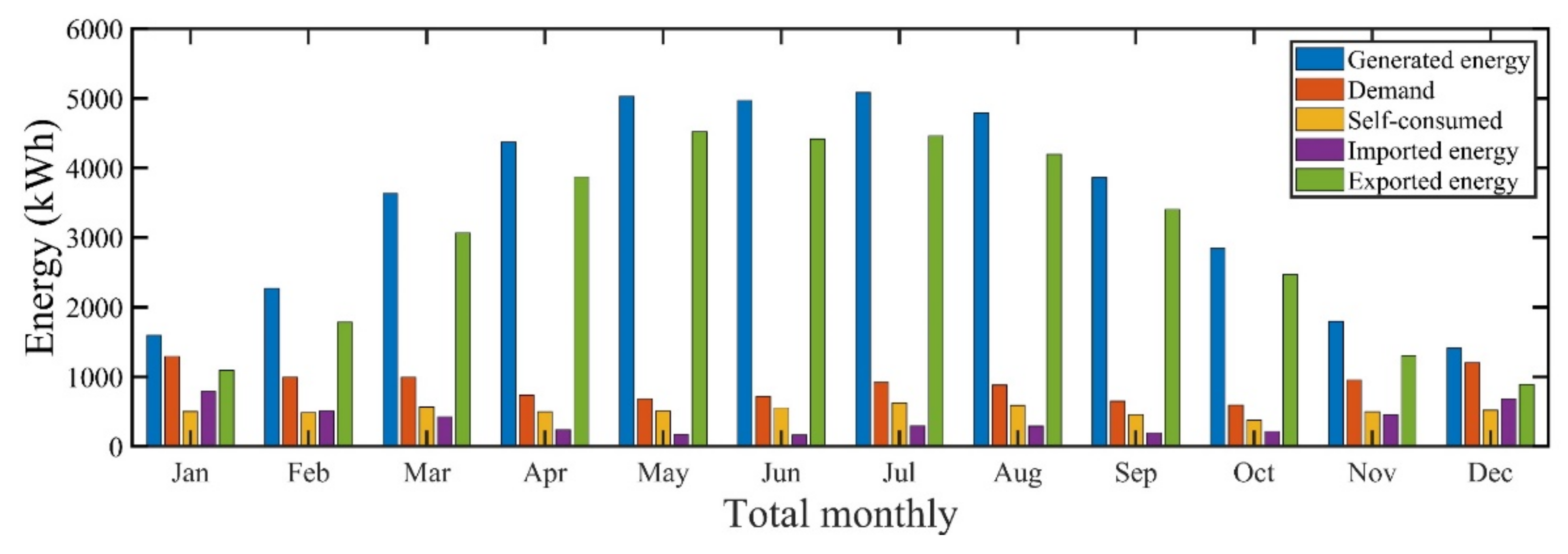Size Optimization of a Grid-Connected Solar–Wind Hybrid System in Net Zero Energy Buildings: A Case Study †
Abstract
:1. Introduction
2. Materials and Methods
3. The Case Study
4. Results
5. Conclusions
Author Contributions
Funding
Informed Consent Statement
Acknowledgments
Conflicts of Interest
References
- Zhu, Z.; Lu, L.; Yao, X.; Zhang, W.; Liu, W. World Energy Balances Overview, 2020th ed.; Publications Office of the European Union: Luxembourg, 2020. [Google Scholar]
- Jahangir, M.H.; Cheraghi, R. Economic and environmental assessment of solar-wind-biomass hybrid renewable energy system supplying rural settlement load. Sustain. Energy Technol. Assess. 2020, 42, 100895. [Google Scholar] [CrossRef]
- Barakat, S.; Ibrahim, H.; Elbaset, A.A. Multi-objective optimization of grid-connected PV-wind hybrid system considering reliability, cost, and environmental aspects. Sustain. Cities Soc. 2020, 60, 102178. [Google Scholar] [CrossRef]
- Ekren, O.; Canbaz, C.H.; Güvel, Ç.B. Sizing of a solar-wind hybrid electric vehicle charging station by using HOMER software. J. Clean. Prod. 2021, 279, 123615. [Google Scholar] [CrossRef]
- Zhang, Y.; Lian, J.; Ma, C.; Yang, Y.; Pang, X.; Wang, L. Optimal sizing of the grid-connected hybrid system integrating hydropower, photovoltaic, and wind considering cascade reservoir connection and photovoltaic-wind complementarity. J. Clean. Prod. 2020, 274, 123100. [Google Scholar] [CrossRef]
- Liu, S.; You, H.; Liu, Y.; Feng, W.; Fu, S. Research on optimal control strategy of wind–solar hybrid system based on power prediction. ISA Trans. 2021, in press. [Google Scholar] [CrossRef] [PubMed]
- Das, B.K.; Alotaibi, M.A.; Das, P.; Islam, M.; Das, S.K.; Hossain, A. Feasibility and techno-economic analysis of stand-alone and grid-connected PV/Wind/Diesel/Batt hybrid energy system: A case study. Energy Strategy Rev. 2021, 37, 100673. [Google Scholar] [CrossRef]
- Maleki, A.; Hafeznia, H.; Rosen, M.A.; Pourfayaz, F. Optimization of a grid-connected hybrid solar-wind-hydrogen CHP system for residential applications by efficient metaheuristic approaches. Appl. Therm. Eng. 2017, 123, 1263–1277. [Google Scholar] [CrossRef]
- Dali, M.; Belhadj, J.; Roboam, X. Hybrid solar–wind system with battery storage operating in grid-connected and standalone mode: Control and energy management—Experimental investigation. Energy 2010, 35, 2587–2595. [Google Scholar] [CrossRef]
- Mikati, M.; Santos, M.; Armenta-Deu, C. Electric grid dependence on the configuration of a small-scale wind and solar power hybrid system. Renew. Energy 2013, 57, 587–593. [Google Scholar] [CrossRef]
- Zhang, D.; Liu, J.; Jiao, S.; Tian, H.; Lou, C.; Zhou, Z.; Zhang, J.; Wang, C.; Zuo, J. Research on the configuration and operation effect of the hybrid solar-wind-battery power generation system based on NSGA-II. Energy 2019, 189, 116121. [Google Scholar] [CrossRef]
- Carpinelli, G.; Caramia, P.; Varilone, P. Multi-linear Monte Carlo simulation method for probabilistic load flow of distribution systems with wind and photovoltaic generation systems. Renew. Energy 2015, 76, 283–295. [Google Scholar] [CrossRef]
- Duffie, J.A.; Beckman, W.A. Solar Engineering of Thermal Processes; Wiley: New York, NY, USA, 1980. [Google Scholar]
- Ciocia, A.; Amato, A.; Di Leo, P.; Fichera, S.; Malgaroli, G.; Spertino, F.; Tzanova, S. Self-Consumption and Self-Sufficiency in Photovoltaic Systems: Effect of Grid Limitation and Storage Installation. Energies 2021, 14, 1591. [Google Scholar] [CrossRef]
- Mavrigiannaki, A.; Gobakis, K.; Kolokotsa, D.; Kalaitzakis, K.; Pisello, A.L.; Piselli, C.; Laskari, M.; Saliari, M.; Assimakopoulos, M.-N.; Pignatta, G.; et al. Zero energy concept at neighborhood level: A case study analysis. Sol. Energy Adv. 2021, 1, 100002. [Google Scholar] [CrossRef]
- Solar Panels. 2021. Available online: https://www.europe-solarstore.com/solar-panels.html (accessed on 17 February 2022).
- Sohani, A.; Naderi, S.; Torabi, F.; Sayyaadi, H.; Akhlaghi, Y.G.; Zhao, X.; Talukdar, K.; Said, Z. Application based multi-objective performance optimization of a proton exchange membrane fuel cell. J. Clean. Prod. 2020, 252, 119567. [Google Scholar] [CrossRef]
- D’Adamo, I.; de Monte, F.; Ferella, F.; Gastaldi, M. The case study of a photovoltaic plant located at the university of L’Aquila: An economic analysis. J. Clean. Prod. 2021, 278, 123561. [Google Scholar] [CrossRef]
- Lal, R. Encyclopedia of Soil Science; CRC Press: Boca Raton, FL, USA, 2006. [Google Scholar]
- Behbahaninia, A.; Banifateme, M.; Azmayesh, M.H.; Naderi, S.; Pignatta, G. Markov and Monte Carlo Simulation of Waste-to-Energy Power Plants Considering Variable Fuel Analysis and Failure Rates. J. Energy Resour. Technol. 2021, 144, 062101. [Google Scholar] [CrossRef]
- Naderi, S.; Banifateme, M.; Pourali, O.; Behbahaninia, A.; MacGill, I.; Pignatta, G. Accurate capacity factor calculation of waste-to-energy power plants based on availability analysis and design/off-design performance. J. Clean. Prod. 2020, 275, 123167. [Google Scholar] [CrossRef]
- List of Products by Manufacturer Braun. 2021. Available online: https://www.wattuneed.com/en/30_braun (accessed on 17 February 2022).
- Sohani, A.; Naderi, S.; Torabi, F. Comprehensive comparative evaluation of different possible optimization scenarios for a polymer electrolyte membrane fuel cell. Energy Convers. Manag. 2019, 191, 247–260. [Google Scholar] [CrossRef]


| Parameter | Unit | Value | Refs. |
|---|---|---|---|
| PV capital cost | EUR/m2 | 118.76 | [16,17] |
| PV panel efficiency | % | 20 | [16,17] |
| Ground albedo | % | 28 | [19,20] |
| Tilt angle | º | 44.55 | [21] |
| WT capital cost | EUR | 10,340 × e (0.1291 × Pr) | [22] |
| Inverter capital cost | EUR | 1182 | [16,17] |
| Inverter efficiency | % | 98 | [23] |
| PV controller capital cost | EUR | 631.36 | [16,17] |
| PV controller efficiency | % | 98 | [16,17] |
| WT controller capital cost | EUR | 565.8 | [16,17] |
| WT controller efficiency | % | 98 | [16,17] |
Publisher’s Note: MDPI stays neutral with regard to jurisdictional claims in published maps and institutional affiliations. |
© 2022 by the authors. Licensee MDPI, Basel, Switzerland. This article is an open access article distributed under the terms and conditions of the Creative Commons Attribution (CC BY) license (https://creativecommons.org/licenses/by/4.0/).
Share and Cite
Bakhtiar, E.S.; Naeimi, A.; Behbahaninia, A.; Pignatta, G. Size Optimization of a Grid-Connected Solar–Wind Hybrid System in Net Zero Energy Buildings: A Case Study. Environ. Sci. Proc. 2021, 12, 12. https://doi.org/10.3390/environsciproc2021012012
Bakhtiar ES, Naeimi A, Behbahaninia A, Pignatta G. Size Optimization of a Grid-Connected Solar–Wind Hybrid System in Net Zero Energy Buildings: A Case Study. Environmental Sciences Proceedings. 2021; 12(1):12. https://doi.org/10.3390/environsciproc2021012012
Chicago/Turabian StyleBakhtiar, Elaheh Sadeghi, Afshin Naeimi, Ali Behbahaninia, and Gloria Pignatta. 2021. "Size Optimization of a Grid-Connected Solar–Wind Hybrid System in Net Zero Energy Buildings: A Case Study" Environmental Sciences Proceedings 12, no. 1: 12. https://doi.org/10.3390/environsciproc2021012012
APA StyleBakhtiar, E. S., Naeimi, A., Behbahaninia, A., & Pignatta, G. (2021). Size Optimization of a Grid-Connected Solar–Wind Hybrid System in Net Zero Energy Buildings: A Case Study. Environmental Sciences Proceedings, 12(1), 12. https://doi.org/10.3390/environsciproc2021012012







